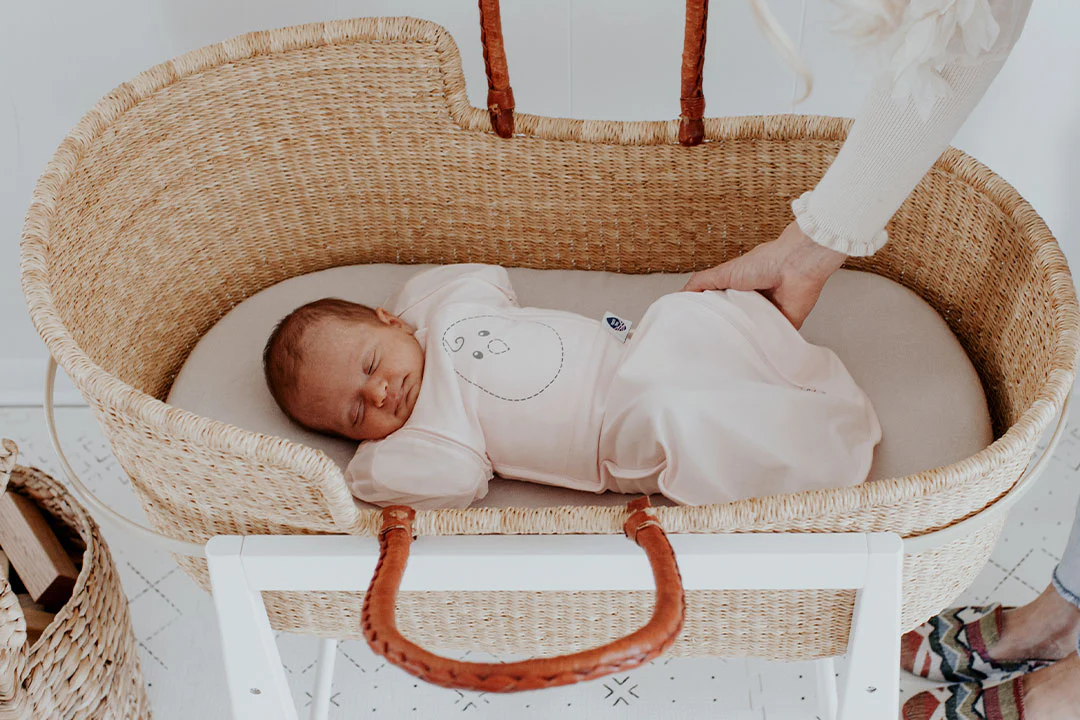
When is the Right Time for Baby to Sleep in Bassinet?
Having a newborn in the world is really joyful, but it also comes with a lot of new duties, including learning about their sleeping habits and setting up a comfortable space for them to sleep in. Choosing the ideal time for your infant to go to sleep in a bassinet is a crucial component of this. A bassinet offers your child a safe and comfortable place to sleep, enhancing their wellbeing and encouraging good sleeping practices. Let’s explore the specifics of when it’s best for your child to move from sleeping on the floor to sleeping in a bassinet.
Recognizing Newborn Sleep Cycles: To meet their feeding demands, newborns have unique sleep cycles that are typified by frequent waking spells, usually every two to three hours. Their quick development requirements and little stomach capacity are the causes of these brief sleep cycles. Babies usually sleep for shorter periods of time and have erratic sleep-wake cycles during the first few weeks of life. With growing, their sleep gradually lengthens into more consistent blocks, creating a more regular schedule.
Benefits of Using a Bassinet: A bassinet improves your baby’s comfort and safety while sleeping. Its small size makes it suitable for use in your bedroom, allowing for overnight feeding and soothing without the need to go vast distances inside your house. Furthermore, the confined space of a bassinet creates a sense of security similar to the womb, fostering a peaceful sleep environment for your infant. Its mobility enables for quick relocation, allowing you to have your baby with you wherever you go.
Factors influencing timing
- Age: Pediatric experts recommend placing newborns in a bassinet from birth, as it provides a suitable sleeping space during the initial weeks of life. As your baby grows and becomes more active, you may gradually transition them to a crib.
- Weight and Size Limitations: Bassinets have weight and size limits that must be followed for your baby’s safety. When your infant reaches these restrictions or shows symptoms of attempting to climb out, it may be time to move to a cot.
- Developmental Milestones: Keep an eye out for your child’s milestones, such rolling over or pulling themselves up onto their hands and knees. These developmental milestones suggest heightened locomotion and may need a shift to a cot in order to optimize safety.
Parental Preference: Ultimately, the decision of when to transition your baby to a bassinet depends on your parental preferences and comfort level. Some parents choose to co-sleep with their baby in a bassinet attached to their bed for easier nighttime care, while others opt for a separate sleeping space.
Tips for Safety Sleeping in Bassinet
When utilizing a bassinet for sleep, it is crucial to ensure your baby’s safety. Observe these rules:
Selecting a Secure Area: Your baby’s safety greatly depends on the area where you set the bassinet. Choose a level, secure platform that is distant from any possible risks, like the floor or a strong bedside table. Make sure there are no wires, blinds, or drapes close by that your child might possibly become tangled in. Additionally, to keep your child’s resting surroundings comfortable, keep the bassinet away from draughty locations, windows, and heaters.
Using a Firm Mattress: To give your infant a sturdy sleeping surface, the mattress within the bassinet has to be firm and supportive. Make sure there are no spaces around the borders where the mattress should fit securely inside the bassinet frame. Gaps may provide entrapment risks, putting your infant at risk for harm. Mattress toppers and additional padding should be avoided as they might weaken the hardness of the sleeping surface and raise the possibility of suffocation.
Avoiding Soft Bedding, Pillows, and Toys: To avoid the danger of suffocation or Sudden Infant Death Syndrome (SIDS), keep all soft bedding, pillows, and toys out of the bassinet. These things may cause asphyxia or raise your baby’s risk of overheating. Instead, put your baby in a lightweight sleep sack or swaddle to keep them warm without using loose blankets. If more warmth is needed, try utilizing a sleep-approved wearable blanket especially for newborns.
Putting Your Baby to Sleep on Their Back: To lower the risk of SIDS, pediatricians advise putting newborns to sleep on their backs, which is the safest posture. This posture reduces the chance of breathing problems during sleep and helps keep your baby’s airway open. When putting a baby to sleep in a bassinet, always start them on their back, even though it’s normal for them to roll onto their stomach or side as they get more mobile. As long as your infant has the power to freely shift their head and neck, you may usually leave them in the position where they have fallen asleep.
Conclusion
Choosing the best time for your infant to sleep in a bassinet requires evaluating a variety of criteria such as age, developmental milestones, and family preferences. A bassinet provides a cosy and safe sleeping environment for your baby from the time he or she is born, encouraging healthy sleep patterns and supporting overall well-being. As your baby develops and becomes more active, you may gently move them to a cot to ensure their sleeping environment is secure and conducive to peaceful sleep. By following safety standards such as positioning the bassinet on a flat surface, removing soft bedding, using a firm mattress, and sleeping on your baby’s back, you may create a caring atmosphere that prioritizes your baby’s comfort and safety. Trust your intuition.